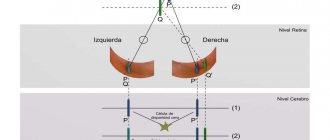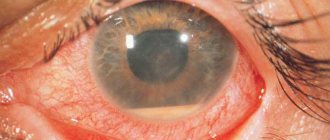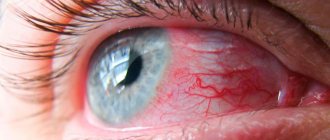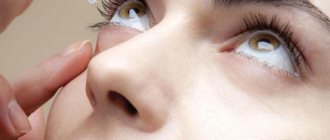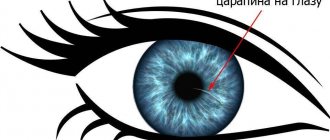Through the pupil, i.e. A hole in the iris allows light to enter the retina, where light-sensitive cells (photoreceptors) are located.
Light reflected from an object forms its image.
Human eyes are also capable of seeing in semi-darkness; for this, the pupil must be dilated as much as possible so that the photoreceptors can receive enough light and record the picture they see. When the sun or other light sources are too bright, the pupil contracts to prevent burns to the retina.
Thus, the diameter of the eye opening is constantly changing, adapting to light and the action of neurotransmitters. This process is the result of the work of the autonomic (vegetative) nervous system, i.e. It is impossible to consciously control the pupil.
You can remove large pupils by using eye drops that are similar in action to the neurotransmitters of the parasympathetic nervous system, which regulate the functioning of the sphincter - the eye muscle that reduces the diameter of the pupil.
Why does the pupil dilate?
The enlargement of the palpebral opening occurs due to the work of the dilator (expander) muscle; the sphincter is responsible for the narrowing. Normally, the pupil diameter varies from 1 to 8 mm. Dilation of more than 5 mm is called mydriasis, as opposed to miosis, when the pupil resembles a point.
When moving from a dark room to a lighted one, the pupil narrows for 5 seconds. The eye should react instantly to bright light. Adaptation to darkness occurs more slowly, the diameter of the pupil increases gradually. Such physiological expansion is normal and does not require treatment, like temporary mydriasis not associated with diseases or drug use.
Causes of pupil dilation:
- normal reaction of the eye to twilight, lack of light;
- the use of mydriatics - substances that dilate the pupil;
- drug intoxication (cocaine, crack, amphetamines, LSD, perevintin, ecstasy);
- withdrawal syndrome;
- emotional, sexual arousal;
- activation of the sympathetic nervous system, release of adrenaline (fear, severe fright, pain);
- hyperfunctional state of the thyroid gland;
- migraine;
- dysfunction of the oculomotor nerve, paralysis of the sphincter of the pupil (Adie-Holmes syndrome);
- skull injuries;
- glaucoma.
By the wide pupils you can determine a person’s sexual interest, in connection with this, ladies used to put drops of belladonna in their eyes, which translated from Italian means “beautiful woman.”
The pupil dilation effect of belladonna (“belladonna”) is due to the atropine content of this plant.
At the same time, the eyes begin to shine greatly, and the nervous system is excited under the influence of atropine. But such mydriasis has a bad effect on the condition of the eyes; unpleasant symptoms may appear: pain, burning, pain in the eyes, photophobia, blurred vision.
Mydriatics that dilate the pupil (Atropine, Irifrin, etc.) are used in ophthalmology when it is necessary to examine the fundus of the eye, for this purpose the pupil is subjected to forced temporary dilation. You can return your eyes to their normal state and quickly narrow the pupils with the help of miotics - eye drops, mydriatic antagonists.
In pathologies, pupil dilation can be unilateral or bilateral.
Glaucoma
Among the ophthalmological diseases, glaucoma should be distinguished, the distinctive feature of which is enlarged pupils of aqua blue color (normally they are black). Glaucoma is characterized by ocular hypertension - an increase in intraocular pressure (IOP) up to 100 mm Hg. (during an acute attack). Normal IOP is 9-20 mm Hg.
Ocular hypertension occurs due to a violation of the outflow of intraocular fluid from the posterior chamber of the eye (behind the iris) to the anterior one. As a result, the accumulated fluid puts pressure on the lens, optic nerve and other structures of the eye, which can lead to serious visual impairment.
For glaucoma (as prescribed by a doctor), eye drops are used to reduce IOP and narrow the pupils.
other methods
There are exotic ways to make your pupils wider at home without drops. You shouldn't take them seriously, but you can try them for fun. The chances of success will increase for those who truly believe in the power of self-persuasion; this technique is called pupillometry. In other words, you can make your pupils wider if you just convince yourself of it.
The power of persuasion will help emotional people achieve the desired effect
The following recommendations will help:
Why are the pupils different sizes?
- You should close your eyes and imagine black objects as clearly as possible. These could be black panthers sneaking around a black city at night, black things hanging in a dark room, etc.
- You can also sit comfortably and try to relax as much as possible. There is no need to close your eyes; on the contrary, you should look into the distance so that your gaze becomes unfocused and all objects become blurry, as if in a haze. The main thing is that the visual image does not start to double. In this case, you need to start the experiment all over again.
- Your pupils will dilate for a short time if you go into a dark room and try to look into the darkest part of it. The effect is achieved due to the fact that the eyes try to catch as much light as possible and the pupil also expands. The same thing will happen if you suddenly turn away from a window on a sunny day or from another source of bright light.
- This method is the most exotic, although doctors cannot explain how and why it works and do not even try. It consists of the following: you need to stand up, pull in your stomach as much as possible, tense your abdominal muscles and hold them in this state for several minutes. They say that the pupils actually become wider.
- To make your pupils dilate, you need to think about something that causes a surge of adrenaline. It could be driving a car or motorcycle fast, skydiving, even sex. During the release of adrenaline or oxytocin, the human body tenses, breathing becomes faster, blood circulation and brain activity are activated, which leads to dilation of the pupils.
Note: scientists have proven that emotions really affect pupil width. So, when a person is angry, they narrow. But if a person experiences something pleasant, the opposite happens. To be convinced of this, it is enough to look into the eyes of your soulmate after intense intimacy.
If you need to dilate the pupils in a photo, you can simply retouch it. Not very honest, but completely harmless and beautiful
One of the easiest ways to achieve a languid look is to drink several cups of strong coffee or any other caffeinated energy drink over a short period of time. This substance stimulates the nervous system, increases blood circulation and increases blood pressure, which also helps dilate the pupils. However, this remedy has a strong effect on the heart and can seriously undermine your health if used too often.
It is safer to buy antiallergic eye drops at the pharmacy and drop them into your eyes, but only in the recommended dosages. Unlike ophthalmic medications designed specifically to dilate the pupil, these are sold without a prescription. But if you get too carried away with such remedies, you can provoke a reverse reaction - redness of the eyes and profuse lacrimation.
Effective and relatively safe products are available in pharmacies that will help you achieve the desired result without any conditions.
And also pupil dilation is one of the side effects of the 5-HTP dietary supplement. It is completely harmless in acceptable dosages, but if abused, it greatly increases serotonin levels. For this reason, 5-HTP cannot be combined with B vitamins. Even seemingly innocent home remedies can cause serious health problems. Therefore, before looking for a way to make your pupils wider, you should think about why.
How to remove dilated pupils
If the pupils are enlarged for natural reasons due to insufficient light or as a result of normal physiological reactions, for example, to severe stress or excitement, then nothing needs to be done about it. It makes sense to worry about dilated pupils only when such a condition negatively affects your health.
Drops
For medicinal purposes, antiglaucoma eye drops are used to constrict the pupils. Uncontrolled use of these medications is not recommended.
Pilocarpine prolong 1%
Eye drops in bottles (5 ml) contain pilocarpine hydrochloride 1% and hypromellose 0.43%.
Application:
- glaucoma, including relief of acute attacks of this disease;
- if necessary, reduce the size of the pupils after using mydriatics;
- retinal vein thrombosis;
- optic nerve atrophy.
Contraindications:
- hypersensitivity to pilocarpine;
- inflammation of the iris (iritis);
- iridocyclitis;
- keratitis;
- severe myopia;
- retinal disinsertion;
- pregnancy.
Side effects:
- painful sensations in the eyes;
- decreased twilight vision due to persistent constriction of the pupils;
- conjunctivitis (with long-term use);
- headache;
- increased salivation;
- bronchospasm;
- allergic reactions.
When Pilocarpine interacts with antagonists, for example, with Atropine, as well as with antidepressants and tranquilizers, the therapeutic effect decreases. When used simultaneously with Phenylephrine and Timolol, the reduction in IOP increases.
Application: instill 1 drop. The number of instillations depends on the doctor’s orders. In case of overdose, Atropine and Epinephrine are administered.
Aceclidine 2%, 3%, 5%
Solution for the preparation of ophthalmic drops. Aceclidine has a strong miotic effect. Used in the treatment of glaucoma.
Contraindications:
- epilepsy;
- bronchial asthma;
- pregnancy;
- individual intolerance.
Side effects:
- salivation;
- feeling of “ache” in the eyes.
Aceclidine is instilled 1-2 drops 3-6 times a day, depending on the therapeutic effect.
Carbachol 1.5%, 3%
After instilling drops of Carbachol, the pupils begin to narrow after 20 minutes. The effect lasts up to 8 hours. The drug also reduces IOP and is used for glaucoma.
Contraindications:
- hypersensitivity to the drug;
- corneal damage;
- acute form of iritis and iridocyclitis;
- bronchial asthma.
Side effects:
- possible spasm of the eye muscle that constricts the pupil;
- pain in the eyes, burning;
- conjunctival hyperemia;
- headache;
- clouding of the lens (in patients over 40 years of age).
For glaucoma, Carbachol is instilled 1-2 drops 3-4 times a day.
Physostigmine 0.25%, 1%
Constricts the pupil 5-15 minutes after application. The effect lasts for more than 3 hours. It is used more often for acute glaucoma.
It is stronger than Pilocarpine, but with severe pain. Used in combination with Pilocarpine.
Apply 1-2 drops up to 6 times a day.
Phosphacol 0.01%, 0.02%
The drug has a prolonged miotic effect.
Application:
- glaucoma, including to relieve an acute attack;
- lens loss;
- corneal damage;
- to reduce the effect of mydriatics (atropine, etc.).
Side effects:
- Pain in the eyes;
- redness;
- headache.
Apply 2 drops 2-3 times a day.
Gymnastics for the eyes
There are exercises that can improve the functionality of the eye muscles responsible for the pupil. They can be done at home or at work. Gymnastics for the eyes also helps to increase the outflow of intraocular fluid, which is especially important for glaucoma.
Gymnastics for the eyes
We recommend reading: 10 eye exercises to improve vision
Set of exercises:
- Extend your hand in front of you, thumb up, focus on the nail, then look at a distant object. You can focus alternately on both fingers, at a distance of 30 cm from each other, looking from the nail into the distance and back. It is better to do this while sitting, with your elbows resting on the table.
- Exercise for training the eye muscles: looking up and down, left and right, circular movements. The head remains in place, only the eyes move.
- Fix your gaze on the moving second hand for 1-3 minutes. It is recommended to use a watch dial with a large diameter.
Repeat each exercise several times, avoiding severe overstrain of the visual organs.
Contrast eye compresses
You can do it simply with water, but it is better to use an infusion of eyebright - an eye herb. You can prepare it by pouring 1 tbsp. dried herbs or a “tea” bag with eyebright with a glass of water at a temperature of 80-90°C, let it brew. Cool part of the infusion in the refrigerator, use part hot, at a tolerable temperature.
Apply a hot bag and a cold one or a cotton pad soaked in eyebright infusion to the eyelids alternately.
Such compresses are very beneficial for the eyes, especially when combined with exercise, proper nutrition and reasonable stress on the visual organs.
Folk remedies
Traditionally, to improve twilight vision, blueberries are used, preferably fresh or dried, or dietary supplements containing blueberry extract.
For glaucoma and for constricting pupils, among folk remedies one can highlight the use of dill and anise seeds. They make an infusion for washing the eyes: 1 tbsp. seeds in a glass of water, crush and infuse. It is also possible to use 1 tsp of ground seeds orally.
We recommend reading: Eye treatment with folk remedies
One of the best medicinal plants for the eyes is eyebright (eye herb). It is used both internally in the form of infusions and for compresses. Relieves inflammation, normalizes blood supply and metabolic processes, which helps reduce IOP and improve vision.
Review of the most popular mydriatics
The very first and most toxic drug from this group, which was known to medicine and was widely used more than a hundred years ago, is Atropine. This is what ladies of past centuries used to add languor to their eyes. The effect after one instillation lasted up to several days, which, of course, was accompanied by side effects and did not benefit the visual organs.
The property of Atropine to quickly and permanently dilate the pupils, turning the gaze into a languid and enticing one, was well known to young ladies in the nineteenth century, which they often used without measure
Today, Atropine is practically not used in ophthalmology; instead, the following drugs are used:
- Topicamide and Mydriacyl. These drugs can be used in pediatrics, as they begin to act within a quarter of an hour after instillation, but the effect lasts no more than three hours. Damage to the eyes is minimal, which is why these mydriatics are used more often than others.
- Ifrin. This drug also does not act for long, but it does affect intraocular pressure. For this reason, it is not prescribed to children under 12 years of age, women expecting a child, or people suffering from vascular and brain diseases.
- Cyclomed. This drug lasts quite a long time, sometimes more than 12 hours. It is used with caution when examining pregnant patients and is not used on children under 3 years of age or the elderly.
There are situations when a doctor needs to use special tools to make an accurate diagnosis, for example, retinal detachment or determine the degree of myopia
The listed drugs are not available in pharmacies without a doctor's prescription; they are used primarily in medical institutions. But if you need to dilate your pupils at home, there are several interesting methods. They may be less effective than medications, but they are much safer.
How drug addicts hide their wide pupils
Taking narcotic drugs impairs the functions of the eyes, the pupil ceases to respond adequately to light. Mydriasis after taking amphetamines and other drugs with a similar effect on the eyes persists as long as the psychoactive substance is active, in this case for about a day, with the exception of cocaine, the effect of which ceases after 1.5 hours. Sometimes dilated pupils last for 2 days, then self-healing occurs.
Heroin, morphine, codeine – unnaturally constrict the pupils for about 5 hours, which leads to severe miosis. In addition to abnormally dilated (or constricted) pupils, drug intoxication can be indicated by “glassy”, glare or cloudy eyes, as well as noticeable redness. In order to hide dilated pupils, Pilocarpine and other eye drops with a miotic effect are used, the uncontrolled use of which can further worsen the health situation.
Gymnastic exercises that reduce pupils
Several exercises will help you get rid of dilated pupils:
- Focusing on an object directly in front of you . Look at some object located at a distance of 20-30 centimeters from you. To view it in detail, the pupil space will automatically narrow. If there are no objects nearby, simply extend your finger at this distance and look at it. If you can, you can focus directly on the tip of your nose.
- Alternating glance left and right . First, look as far as possible in one direction, then in the other, and so on several times. Leave your head motionless.
- Alternating look down and up . This exercise resembles turning your eyes left and right. And the effect will be the same.
- Ceiling-corner exercise . Look at the ceiling, and then sharply shift your gaze to the corner of the room farthest from you.
- Circular rotations . Imagine a large dial right in front of you. First, look around it clockwise and then counterclockwise.
- Relaxation of abdominal muscles . The principle of operation of this exercise is not clear. But if you relax your abdominal muscles, your pupils instantly become smaller.
Attention! It is not possible to remove wide pupils for a long time with the help of exercises. Gymnastics gives a very short-term effect: from a few seconds to several minutes. However, this is often enough to achieve your goal.
The role of light in changing pupil size
For persistent constriction of the pupils, choose a room with bright lighting or organize it yourself. The more light there is, the smaller the gap in the iris will be. You can simply turn on as many lights as possible. If this is not possible, then look, trying not to close your eyes, at the lamp for several minutes. If you are in a dark room, you can use a flashlight or even a flashlight or cell phone flash instead of a lamp.
Attention! The reaction of the pupil to bright light is immediate, but the effect in low light conditions is short-lived.
Useful video
From this video you will learn how to make a diagnosis using the eyes:
Constriction of the pupils is a procedure that people do not need in everyday life .
sometimes to induce such a reaction after examinations performed with the use of mydriatic drugs.
And in order to avoid side effects and negative effects on the visual organs, the purchase and use of miotics without appropriate indications and a doctor’s prescription is not recommended.
Pupil dilation is a phenomenon that can occur due to pathological reasons or under the influence of medications. A similar phenomenon is characteristic of spasm of the ciliary muscle. In this case, visual acuity may be impaired.
Constriction of pupils
It doesn't matter what exactly caused the expansion. The pupil can be narrowed using ophthalmic solutions. Now let's take a closer look at how to constrict your pupils.
Methods for constricting pupils using folk remedies
Using folk remedies, you can achieve normalization of the iris. For this purpose, decoctions and infusions are prepared based on various plants that have medicinal properties.
Blueberry
Pour boiled water over a glass of blueberries and leave to cool. Take this decoction at least four times a day, about sixty millimeters. If a real plant is not available, it can be replaced with pharmaceutical tablets or blueberry juice.
Raspberries
Raspberry leaves are used to constrict the pupils. Boil them. Take the resulting decoction twice a day (200 ml).
The anise-based recipe is similar to the raspberry one. Anise improves blood circulation in the retinal area of the eyes and helps in constricting the pupils.
There are quite a large number of methods that help to narrow the pupils, both without the use of medications and with their help. But when resorting to any of them, you must first consult with your treating ophthalmologist.
Folk remedies for pupil reduction
Folk remedies for constricting pupils do not give immediate results. But if they are used in courses, then after some time it will be possible to have a slight but permanent reduction in the diameter of the pupillary opening. This can help:
- Blueberry . Eat as many berries as possible or drink preparations containing blueberry extract. You can make compote from the berries and drink 1 glass of it 4 times a day. Blueberries will also help restore vision.
- Raspberries . The effect of this berry is similar to blueberries. You can not only eat fresh berries, but also take medications with it. Not only the fruits, but also the leaves will be useful. You can prepare them for the winter and make a drink from them, adding a little sugar or honey.
- Anise . A decoction of anise herb will bring even more benefits. It will not only cause myiasis, but also improve blood circulation in the tissues of the eyeball, and especially in the retina. This is perhaps the most useful way to reduce pupil size.
Now you know how to constrict your pupils: we have presented you with all the ways to achieve myiasis. But remember that eye health is the basis of good vision. Therefore, do not resort to medication every time you need to narrow the pupillary opening. It’s better to learn to control the gap in the iris through simple exercises or resort to traditional methods.




